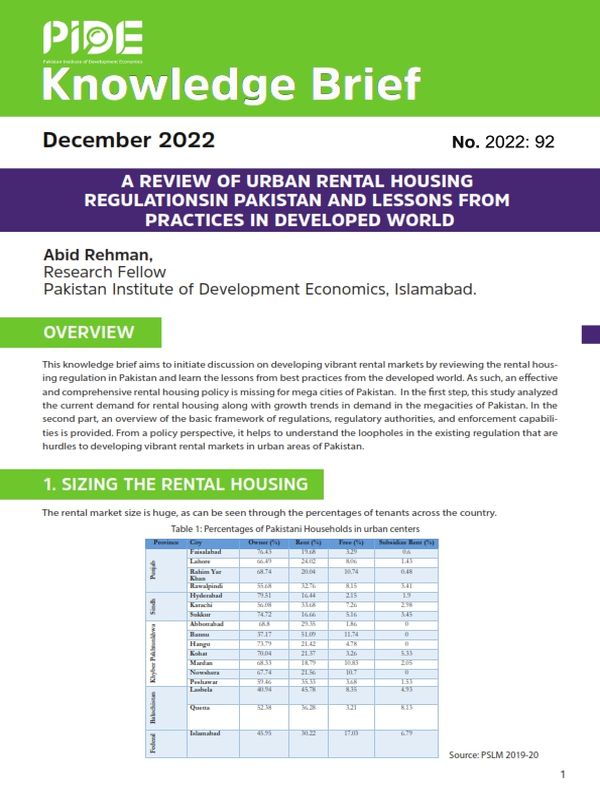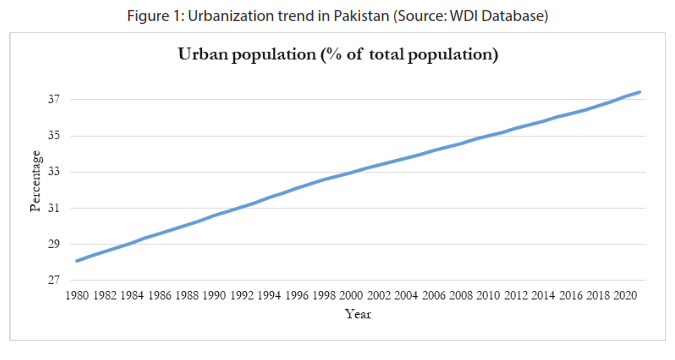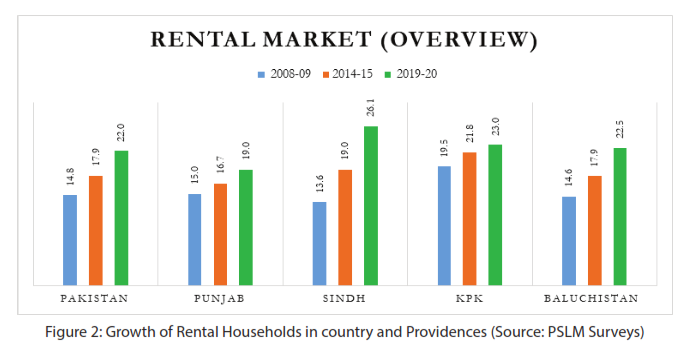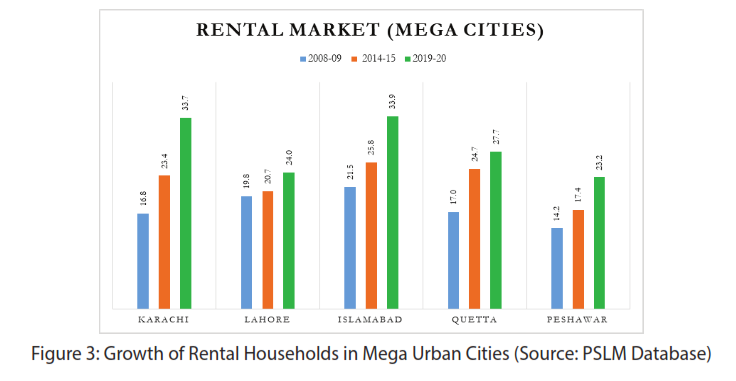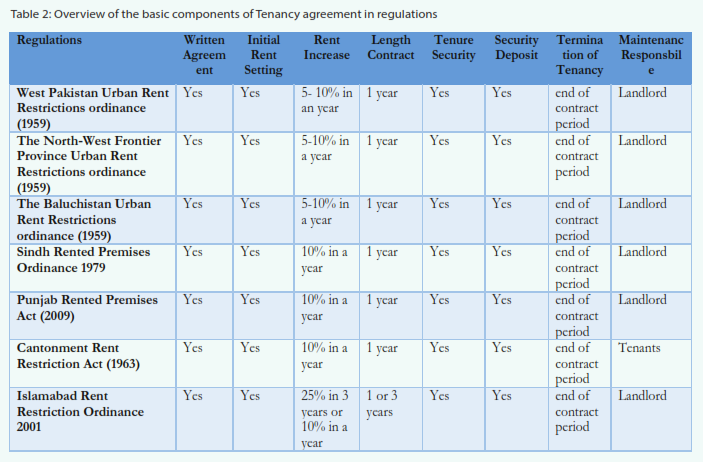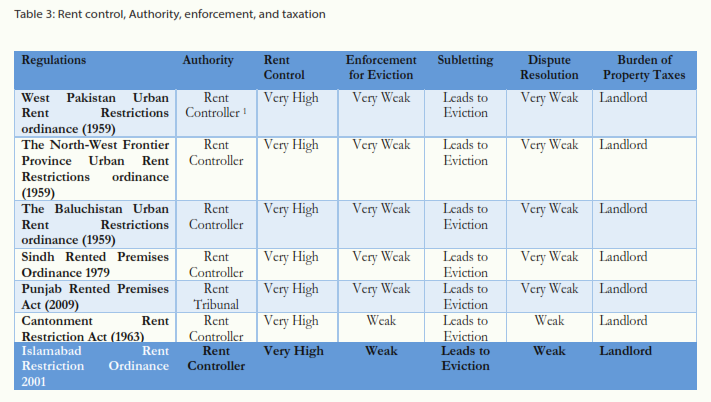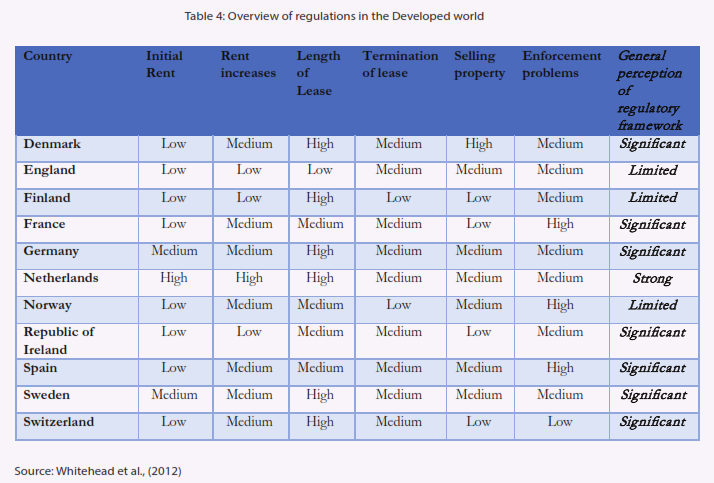A Review of Urban Rental Housing Regulations in Pakistan and Lessons from Practices in Developed World
Overview
This knowledge brief aims to initiate discussion on developing vibrant rental markets by reviewing the rental housing regulation in Pakistan and learn the lessons from best practices from the developed world. As such, an effective and comprehensive rental housing policy is missing for mega cities of Pakistan. In the first step, this study analyzed the current demand for rental housing along with growth trends in demand in the megacities of Pakistan. In the second part, an overview of the basic framework of regulations, regulatory authorities, and enforcement capabilities is provided. From a policy perspective, it helps to understand the loopholes in the existing regulation that are hurdles to developing vibrant rental markets in urban areas of Pakistan.
- Sizing the Rental Housing
The rental market size is huge, as can be seen through the percentages of tenants across the country.
- Growing Demand for Rental Housing
Pakistan has become a growing rental market in urban areas primarily because of two reasons:
- Housing Unaffordability
- Urbanization Trends
Moreover, if we focus on the mega cities, especially the capital of all provinces and Pakistan, the demand for rental housing has been increasing rapidly (see Figure 3).
- Review of Rental Laws in Pakistan
The demand for rental housing is increasing at a rapid pace. However, there are regulatory, supply and demand, taxation, and financing constraints that are hurdles to the vibrant rental market. As such, the structure of the rental market is highly rigid, and regulations are the main hurdles to the development of housing in Pakistan. It is also important to mention here that all these regulations were amended in 2014 and 2015, keeping in view security concerns by adding the clause that the information and copy of identity cards of temporary residents should be submitted to the nearby police station. The enforcement of this clause was very effective in coping with terrorism activities.
Table 2 and Table 3 provide content analysis of the following seven rental laws that are applicable in the country.
- West Pakistan Urban Rent Restrictions ordinance (1959)
- The North-West Frontier Province Urban Rent Restrictions ordinance (1959)– The KP and Information of Temporary Resident Act (2014)
- The Baluchistan Urban Rent Restrictions ordinance (1959)– The Baluchistan Information of Temporary Resident Act (2015)
- Sindh Rented Premises ordinance (1979) – The Sindh information of temporary residents acts (2015)
- Punjab Rented Premises Act (2009) – The Punjab Information of Temporary Resident Act (2015)
- Cantonment Rent Restriction Act (1963)
- Islamabad Rent Restriction Ordinance 2001 – (2014 & 2019) Amendments
The two matrices above (Tables 2 & 3) analyze the essential components of tenancy agreements in regulations along with the evaluation of authorities that enforce these regulations and taxation-related matters. It offers a good understanding of the loopholes in the regulatory structure.
The legislation and implementation of rental regulations are the subject matter of provinces, and enforcement of these regulations is the responsibility of district administration through the rent controller. In case of any violation written in the agreement by tenants or landlords, the application is submitted to the rent controller through the lawyer. The rent controller will hear both party lawyers and give his decision in favor of the righteous party. Table 3 above explains the rent control and enforcement of the reviewed regulation. The rent control is very high in all the regulations, as inflation is always very high in Pakistan. However, the Rent cannot be increased by more than 10% and, in some cases, 5%. Which yield low return to investors and less incentive for the landlords. Moreover, the court procedures for the eviction of tenants through district administration are prolonged and uncertain, as regulations are pro-tenants, affecting the supply of rental housing.
_______
[1] Rent Controller is basically a Civil Judge but functions as person designate to decide the cases expeditiously and un-hampered by the laws relating to evidence or procedure.
_______
- Stumbling Regulatory Blocks to Vibrant Rental Market
Based on the review of regulation, the following loopholes have been found that should be addressed for the development of the rental market.
- Colonial regulations – very similar to each other & with no serious reforms since 1959.
- Failing to distinguish between the two major types of tenancy (commercial and residential).
- Fails to balance between the rights and liabilities of both landlord and tenant as regulations are pro-tenants.
- Fails to have a proper mechanism for the enforcement of eviction from tenants and dispute resolution.
- Stringent Rent control, over-regulation, and low enforcement of these acts limit investment return resulting in a decline in the rental housing supply.
- In addition, rent control and over-regulation balloons public expenditures due to getting NOCs by wasting time through lengthy administrative procedures.
- Review & Comparative Analysis of Regulations in Developed world
In the developed world, the regulatory frameworks facilitate both parties’ tenants and landlords. Moreover, the enforcement mechanism in the developed world is robust that provides the foundation for a vibrant rental market. The summary of the review from the developed world is presented in Table 4.
- Way Forward (Lesson to Learn from Developed World)
Pakistan’s rental market is yet to mature due to over regulations, strict rental control acts, and more inclination for protecting the right of tenants. The first step is to develop and draft a revised tenancy act based on the loopholes identified in the review of the prevailing tenancy acts in Pakistan and the practices of the developed world. So, there is a need to put serious efforts into the development of acts that reduce regulatory constraints and push the market towards limited regulatory regimes. From the best practices in Table 5, we can have evidence that apart from the Netherlands all the other developed European countries deregulated their rental housing markets. The deregulation trends can be seen in most countries compared to 1980’s. This reveals that in order to make the rental markets vibrant, the government footprint through strict regulations should be reduced with the minimization of administrative procedures and NOCs so that there is an incentive for investors to invest in the rental property. Second, the enforcement of these regulations for eviction from tenants and dispute resolution is very weak, which create many uncertainties in the mind of landlord and they avoid renting the house to avoid the situation in which tenants grabbed their house. There is a need to empower the landlords through these regulations so they can confidently give their house on Rent without fear of “Qabza”. As can see through the practices of developed European countries (Table 4), the enforcement mechanism is either medium or high, which reflect the importance of cumbersome and straightforward enforcement mechanism for the development of vibrant rental markets. Third, the rent increase in megacities (esp., Islamabad, Lahore & Karachi) is very explosive. Based on the practices of developed European countries (Table 4), there should be rent controls by linking the rental increments with the inflation rate. Fourth, while the majority focusing on mega cities (Lahore and Karachi), we are ignoring the situation of rental housing in the intermediate and small cities (See Table 1), such as the (Bannu, Lasblea, Quetta, and Abbottabad). There is a need to focus on research on emerging and intermediate cities for the development of vibrant rental markets. Fifth, all the rental acts and regulation mainly deals with residential tenants and fails to make the distinction between commercial and residential tenants. There is a need to draft new rental acts for commercial tenants as the rent structures, and security is very different. For future work on making the rental market vibrant, along with regulatory reforms, there is also a need to address the issues related to digitization of the rental market and minimizing the upfront cost (excluding the middle man) so landlords and tenants have access to the information.
References:
Cantonment Rent Restriction Act (1963): http://cbg.gov.pk/
Government of Pakistan, (2009). Pakistan social and living standard measurement survey (PSLM) 2008-09. Federal Bureau of Statistics, Islamabad
Government of Pakistan, (2015). Pakistan social and living standard measurement survey (PSLM) 2014-15. Federal Bureau of Statistics, Islamabad
Government of Pakistan, (2020). Pakistan social and living standard measurement survey (PSLM) 2019-20. Federal Bureau of Statistics, Islamabad
Islamabad Rent Restriction Ordinance 2001 – (2014 & 2019) Amendments https://na.gov.pk/
Punjab Rented Premises Act (2009) – The Punjab Information of Temporary Resident Act (2015). http://punjablaws.gov.pk/
Sindh Rented Premises ordinance (1979) http://sindhlaws.gov.pk/
The Baluchistan Urban Rent Restrictions ordinance (1959) http://kpcode.kp.gov.pk/
The KP and Information of Temporary Resident Act (2014) https://kpcode.kp.gov.pk/
The North-West Frontier Province Urban Rent Restrictions ordinance (1959) http://kpcode.kp.gov.pk/
The Sindh information of temporary residents acts (2015) http://www.pas.gov.pk/
West Pakistan Urban Rent Restrictions ordinance (1959): http://kpcode.kp.gov.pk/
Whitehead, C., Monk, S., Scanlon, K., Markkanen, S., & Tang, C. (2012). The private rented sector in the new century: a comparative approach. Copenhagen: Boligokonimisk Videncenter.


